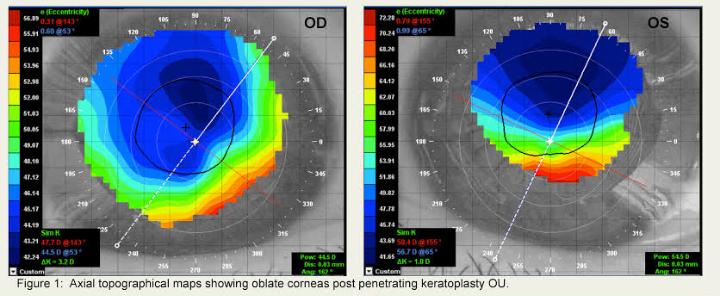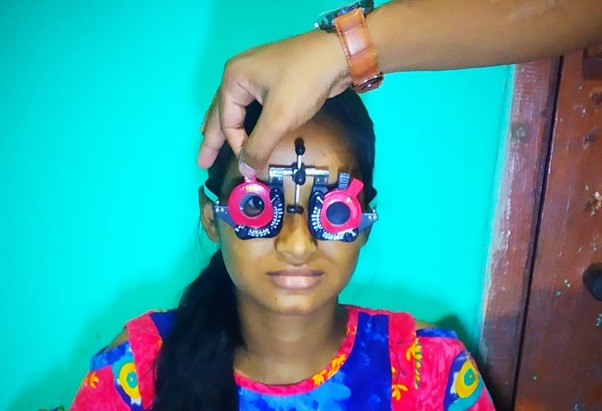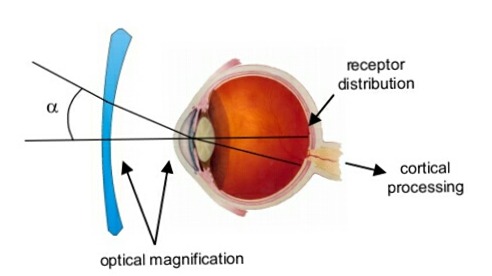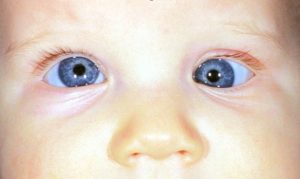Aniseikonia is a condition where the ocular image of an object seen unequal in size and shape.
That means actually, “not equal image” from two eyes. In most of patient is one of the problem most frequent occurred with the correction of anisometropia with spectacle. Aniseikonia is an anomaly of the binocular visual process that can effects the perceptual judgement. The difference size of magnification produce different sized retinal image. 5% of aniseikonia can tolerable. Approx 1/3 of cases of aniseikonia are previse from anisometropia. 3-5%of people are generally high symptomatic of aniseikonia. In aniseikonia asthenopia, photophobia, mobility, vetigo – dizziness, distorted space perception, headache are symptoms. Mainly headache and asthenopia are more common than distorted space perceptions.
If we classify aniseikonia, there come 3 points i. e
(1) optical (axial refractive).
(2) physiologic
(3) Neurologic.
Aniseikonia has so many clinically significant like strabismus, amblyopia, low stereopsis, astigmatism, anisometropia, aphakia. we can analysis aniseikonia by spectacles prescription, keratometry, a scan, IOL status.
Treatment of Aniseikonia
A aniseikonia patient is told that his problem can be solve by covering one eye. Aniseikonia symptoms can often be reduced by changing the magnification properties of the auxiliary optics of the patient. There are 4 way of optical solutions will be vary patient.
Below 4 possible optical solutions will be discussed retaking the amount of aniseikonia has been measured. It is best to measure the aniseikonia before desiring and prescription a specialised correction, not all the eye specialist may have testing equipment.
Contact Lenses
If patient is comfortable with contact lens uses, the first opinion that should be calculated is what the remaining aniseikonia would be if all of the patient’s were put into contact lens. Special in anisometropia contact lens often give less aniseikonia than regular spectacle lens.
contact lenses is the 1st opinion for refractive aniseikonia. corneal ectasia is not necessary to make a contact lens preferably for aniseikonia.
knpp’s law mathematically estimate when contact lens correction of aniseikonia is indicated.
knpp’s law predicts that contact lenses, are ideal for the correction of refractive aniseikonia. where, the spectacle would be ideal for axial aniseikonia.
knapp’s law neglect retinal and axial aniseikonia. sometime, many old age patients cannot and not attempt contact lens contact lens correction. Even something, contact lens easy to use but sometimes they are not sufficient to ignore symptoms, as the above case.
Spectacle Lens
aniseikonia is occur by magnification properties inherent in all ophthalmic corrective lens. A spectacle correction is used to treat aniseikonia, depends on base curve, center thickness, dioptric power, vertex distance can all be used to magnify the retinal image.
slab-offs cannot correct the magnification imbalance present in aniseikonia. In these case, correction is made by iseikonic spectacle, in which a smaller retinal image is increased to match the magnification of smaller image of the counter image.
This is made by –
1. altering the front curve
2. the centre thickness
3. or the vertex distance.
Dispensers interested in fitting aniseikonic prescription should familiaze themselves with a number of special techniques required for adjusting iseikonic spectacles. Aniseikonia is usually noted when a patient, for the sake of comfort, prefers to use one eye for reading. If an individual can learn to rely on nonsteoscopic, rather than stereoscopic clues, they may be able to avoid irritation from aniseikonia, even when it is present.
Refractive corneal surgery
Aniseikonia cause to uniocular aphakia is best corrected surgically by IOL implantation. And also retinal aniseikonia is corrected by treating causative retinal disease.
Combination Lens
contact lens and spectacle combination can be treat aniseikonia, of particular interest is in the galilean contact lens telescope. This type of uncommon treatment is useful for eliminate symptomatic but large amount of aniseikonia.









The comment that a 5% size difference between the two eyes is plainly absurt. Even samml differences from o.755 Overall can be a nightmare for certain people. When the size difference is in the range of 1.5% there are maladaptations usually a supression of vision in one eye. That supression may reduce or eliminate the subjective symptoms, but will be a curse for that person. An example of that in a pationed that i interviewed was that when she played tennis her right field was not available to her to respond to any activity in her right field. It is possible to employ partial or nasal occlusion to the fellow eye as a trial approach to see if the response is amenable to anti supression optometric Vision therapy, and/or an evaluation for aniseikonia which is likely to be the culpret. Again, to believe that higher degrees of size differences can be adapted is wishful thinking on the part of the practioner that somehow thinks that it is possible. I have treated scores of aniseikonia patients using iseikonic spectacle lenses that completely eliminated the plague of aniseikonia.